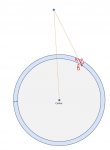brandonnotgoodatmath
New member
- Joined
- Jan 8, 2019
- Messages
- 4
Hi all,
I am new to this forum and looking for some help. I have a task to determine the amount of cloud cover a signal will encounter from a satellite ground station to a satellite. I need to determine the formula so that I can check for multiple locations. Any help would be much appreciated!
satellite. I need to determine the formula so that I can check for multiple locations. Any help would be much appreciated!
I imagine a point on earth (say in Munich), pointing towards a satellite with an azimuth of 120 (degrees) and an elevation of 30 (degrees). Cloud cover for this area is from ground level to 10000m (making this up as I go). So the earth is one circle, with the could cover being a slightly larger circle, and I would like to find all sides of the triangle. The hyp. from the originating point through the cloud cover to the point when it exits the clouds would be leg "C". The distance from the top of the clouds to the earths surface is know at 10000m and will be leg "A". And the originating point to point on earth directly below where the signal exits the could cover will be leg "B". See the illustration.
I'm also looking for the coordinates of the point AB.
Summary:
Circle 1 = Earths radius
Circle 2 = Could cover radius (10000m larger than earth)
Originating point = BC (Lat/Lon:47°59'44.8"N 11°07'17.3"E) <-- Yes, I picked a point on a lake
Exit clouds point = AC
Point below exit = AB
Angle of BC = 30 (deg)
Angle of AB = 90 (deg)
Azimuth = 120 (deg) don't think this is relevant other than to find lat/lon of point AB
Thank you in advance!!!
Brandon
I am new to this forum and looking for some help. I have a task to determine the amount of cloud cover a signal will encounter from a satellite ground station to a
 satellite. I need to determine the formula so that I can check for multiple locations. Any help would be much appreciated!
satellite. I need to determine the formula so that I can check for multiple locations. Any help would be much appreciated!I imagine a point on earth (say in Munich), pointing towards a satellite with an azimuth of 120 (degrees) and an elevation of 30 (degrees). Cloud cover for this area is from ground level to 10000m (making this up as I go). So the earth is one circle, with the could cover being a slightly larger circle, and I would like to find all sides of the triangle. The hyp. from the originating point through the cloud cover to the point when it exits the clouds would be leg "C". The distance from the top of the clouds to the earths surface is know at 10000m and will be leg "A". And the originating point to point on earth directly below where the signal exits the could cover will be leg "B". See the illustration.
I'm also looking for the coordinates of the point AB.
Summary:
Circle 1 = Earths radius
Circle 2 = Could cover radius (10000m larger than earth)
Originating point = BC (Lat/Lon:47°59'44.8"N 11°07'17.3"E) <-- Yes, I picked a point on a lake
Exit clouds point = AC
Point below exit = AB
Angle of BC = 30 (deg)
Angle of AB = 90 (deg)
Azimuth = 120 (deg) don't think this is relevant other than to find lat/lon of point AB
Thank you in advance!!!
Brandon

